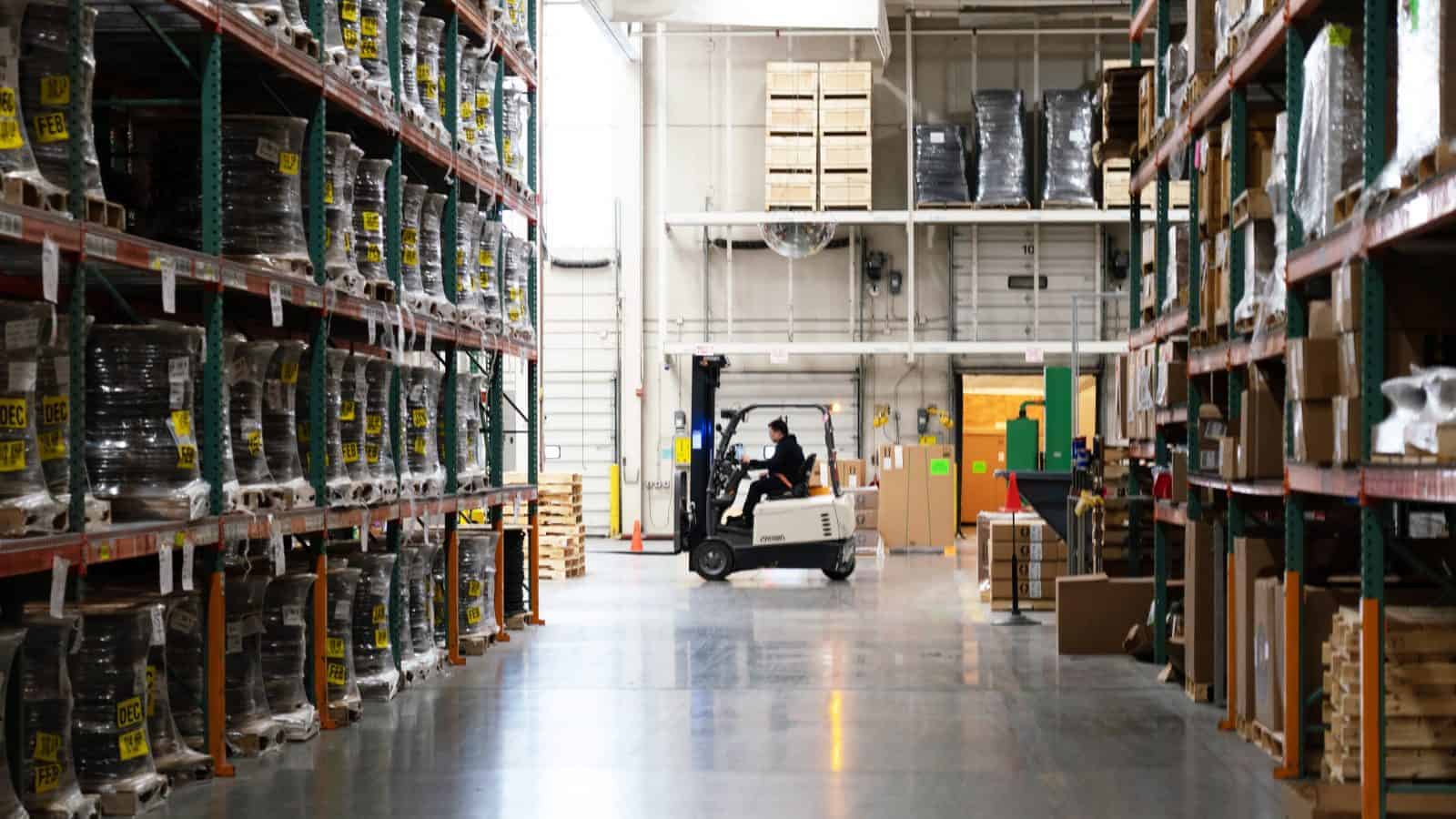Mexico, Canada Tariffs Paused

By deciding to pause the imposition of tariffs he announced last weekend on Mexico and Canada, President Trump shows he’s hearing manufacturers “loud and clear,” the NAM said yesterday.
What’s going on: Two days after signing three separate executive orders under the International Emergency Economic Powers Act to add new levies on goods from Mexico, Canada and China, President Trump announced a one-month pause yesterday on the 25% tariff on Mexican goods and the 25% tariff on Canadian goods, including the 10% levy on energy products.
- President Trump, who had cited illegal immigration and the flow of illicit drugs into the U.S. as the impetus for the new tariffs, said Mexican President Claudia Sheinbaum agreed Monday morning to “immediately supply” 10,000 Mexican National Guard troops to the border.
- The announcement about the tariffs on goods from Canada came following an afternoon phone call between President Trump and Canadian Prime Minister Justin Trudeau.
- The 10% additional tariff applying to products from China went into effect today. In response, China announced retaliatory tariffs on certain goods imported from the U.S., as well as additional restrictions on critical minerals exports to the U.S. (The Wall Street Journal, subscription).
Staying competitive: “This decision by President Trump reflects his swift move to keep his campaign promises, balancing a commitment to aggressive border enforcement with the need to keep manufacturing in the United States competitive,” NAM Executive Vice President Erin Streeter said.
- “The NAM has worked closely with the administration, ensuring that the voices of manufacturers were heard loud and clear. Throughout the weekend, we engaged directly with senior officials, providing key data and real-world industry perspectives. Our efforts helped underscore the risks of broad-based tariffs and the importance of North American supply chains to manufacturing’s success.”
- NAM President and CEO Jay Timmons reinforced President Trump’s and the manufacturing sector’s priorities in interviews Monday with CNBC and ABC, as well as in a statement cited by the Wall Street Journal editorial board.
Certainty needed: For manufacturing in the U.S. to thrive, “we need to bring costs down,” Timmons told ABC. “And if you don’t have that, or you have the uncertainty of what’s coming next, manufacturers are reluctant to invest in new plants and equipment and facilities. They’re reluctant to hire new workers … raise wages or increase benefits. … Once we get all this sorted out, I think it will be good news for manufacturers,” but the sooner that happens, the better, he concluded.
- Timmons also discussed President Trump’s landmark 2020 U.S.–Mexico–Canada Agreement, which he said provided manufacturers with the certainty the sector requires.
- “The certainty that was provided by a negotiated and accepted trade agreement by the three countries enabled manufacturers to make investment decisions,” Timmons told CNBC. “Now we have more uncertainty about what’s ahead … but we assume that there is a rationale for this.”
Key statistics: The USMCA was vital in shifting key imports away from China to North America. According to a new NAM fact sheet:
- Fully one-third of all U.S. manufacturing inputs come from Canada and Mexico;
- Some 70% of what we import from Canada and nearly 60% of imports from Mexico are capital equipment, industrial supplies and automotive parts that go into further manufacturing in the U.S.; and
- The value of U.S. imports of manufacturing materials from North America is now three times greater than the value of materials coming from China.
The bottom line: “We appreciate the administration’s continued willingness to receive our data and manufacturing stories,” Streeter went on. “We will continue working with policymakers to ensure that future decisions support both national security and manufacturing’s success.”
NAM in the news: The NAM’s advocacy received widespread attention in the media, with Fox Business, CNBC, Bloomberg (subscription), CNN, The New York Times (subscription), Punchbowl News and a Wall Street Journal (subscription) article all highlighting its statements on the impact of tariffs on manufacturers.
- Its positions were also mentioned on “Bloomberg Surveillance,” CTV News Channel, MSNBC’s “Inside with Jen Psaki” and MSNBC’s “Morning Joe.”
NAM Update: President Trump Imposes New Tariffs on Canada, Mexico and China
On Feb. 1, President Donald Trump imposed 25% tariffs on products from Canada with lower 10% on energy products, 25% tariffs on products from Mexico and an additional 10% on products from the People’s Republic of China.
NAM Vice President of International Policy Andrea Durkin and her team break down the actions for manufacturers:
Executive orders impose tariffs on Canada, China and Mexico: On Feb. 1, President Trump, through three separate executive orders, declared a national emergency and invoked the International Emergency Economic Powers Act to apply ad valorem tariffs on products from Canada, Mexico and China, citing the sustained influx of illicit opioids and other drugs.
- Canada Executive Order:“Imposing Duties to Address the Flow of Illicit Drugs Across Our Northern Border”
- China Executive Order: “Imposing Duties to Address the Synthetic Opioid Supply Chain in the People’s Republic of China”
- Mexico Executive Order: “Imposing Duties to Address the Situation at the Southern Border”
How tariffs will apply:
- For products from Canada:
- A 25% tariff will be applied in addition to any already applicable duties, fees or charges.
- A 10% tariff will be applied to “energy or energy resources” defined as crude oil, natural gas, lease condensates, natural gas liquids, refined petroleum products, uranium, coal, biofuels, geothermal heat, hydropower and critical minerals.
- For products from China:
- A 10% tariff will be applied in addition to any already applicable duties, fees or charges.
- For products from Mexico:
- A 25% tariff will be applied in addition to any already applicable duties, fees or charges.
- No duty drawback:No drawback shall be available with respect to the duties imposed pursuant to these orders.
- De minimis: Duty-free de minimis treatment will be suspended.
Timing of the tariffs:
- Tariffs will apply from Feb. 4, 2025.
- Tariffs will not apply to goods loaded onto a vessel or in transit before 12:01 a.m. Feb. 1 with certification to U.S. Customs.
Duration of tariffs: The tariffs will remain in place until the president determines that the governments of Canada, Mexico and/or China have taken “sufficient action to alleviate the crisis,” including through cooperative enforcement actions.
A retaliation clause: The president may increase or expand in scope the tariffs imposed under these executive orders if the governments of Canada, Mexico and/or China impose retaliatory tariffs.
Reports to Congress: The Secretary of Homeland Security, in coordination with the Secretary of the Treasury and other agencies, will submit recurring and final reports to Congress on the state of the national emergency under these orders.
What’s next: The NAM issued a statement in response, and the NAM trade team is analyzing the impact on manufacturers and will continue to engage policymakers on these sweeping trade actions.
Manufacturers on Executive Orders to Impose Tariffs
Washington, D.C. – National Association of Manufacturers President and CEO Jay Timmons released the following statement on the executive orders imposing significant tariffs on imports from Canada, Mexico and China.
“Manufacturers understand the need to deal with any sort of crisis that involves illicit drugs crossing our border, and we hope the three countries can come together quickly to confront this challenge.
“At the same time, protecting manufacturing gains that have come from our strong North American partnership is vital. The success of President Trump’s landmark trade agreement, the United States-Mexico-Canada Agreement, has strengthened North American supply chains and bolstered economic power across the region, boosting jobs, wages and investments here in the United States.
“Thanks to this agreement, one-third of critical U.S. manufacturing inputs now come from Canada or Mexico, rather than from competitors like China that often engage in unfair trade practices.
“However, with essential tax reforms left on the cutting room floor by the last Congress and the Biden administration, manufacturers are already facing mounting cost pressures. A 25% tariff on Canada and Mexico threatens to upend the very supply chains that have made U.S. manufacturing more competitive globally. The ripple effects will be severe, particularly for small and medium-sized manufacturers that lack the flexibility and capital to rapidly find alternative suppliers or absorb skyrocketing energy costs. These businesses—employing millions of American workers—will face significant disruptions. Ultimately, manufacturers will bear the brunt of these tariffs, undermining our ability to sell our products at a competitive price and putting American jobs at risk.
“We stand ready to work with President Trump to ensure a trade strategy that reinforces American strength—holding bad actors accountable while preserving the gains of the successful USMCA and advancing policies that sustain manufacturing growth here at home.”
-NAM-
The National Association of Manufacturers is the largest manufacturing association in the United States, representing small and large manufacturers in every industrial sector and in all 50 states. Manufacturing employs nearly 13 million men and women, contributes $2.93 trillion to the U.S. economy annually and accounts for 53% of private-sector research and development. The NAM is the powerful voice of the manufacturing community and the leading advocate for a policy agenda that helps manufacturers compete in the global economy and create jobs across the United States. For more information about the NAM or to follow us on Twitter and Facebook, please visit www.nam.org.
A First Look at Trump’s Trade Policy

In his first few hours in office, President Trump outlined the broad contours of his “America First Trade Policy.” Among the primary objectives: to “reduce dependence on foreign nations for critical supply chains,” “promote investment and productivity” and “enhance our [n]ation’s industrial and technological advantages.”
Key takeaways: The president did not announce new tariffs. His executive order instructs key agencies to begin looking at underlying concerns about unfair or unbalanced trade, specific concerns regarding trade with China and matters related to economic security. The findings could form the basis for the administration’s choice of remedy, potentially leading to more tariffs and other policy measures.
- President Trump “is wasting no time in taking action to strengthen America’s hand on trade, and manufacturers appreciate his focus on combatting unfair practices that hurt American workers,” NAM President and CEO Jay Timmons wrote on Tuesday.
What comes next: Three comprehensive reports are due by agencies to the President by April 1. Issues to be investigated include:
- Persistent trade deficits;
- Unfair trade practices;
- Currency manipulation;
- Importation of counterfeit products and contraband;
- China’s compliance with the “Phase One” deal; and
- Review of the U.S. export control system.
Tariffs on Canada, Mexico and China: The EO tasks the Commerce Department with assessing unlawful migration and fentanyl flows from Canada, Mexico and China. The findings are also due April 1.
- Prior to that date, President Trump could issue a separate EO using international emergency powers. This would enable him to impose tariffs sooner.
Building on past success: The president cited the China Phase One deal, the United States–Mexico–Canada Agreement and Section 232 tariffs as successful elements of his first-term agenda.
Expect USMCA review to kick into gear: The EO also instructs the United States Trade Representative to begin its public consultation processes in preparation for the six-year review of the USMCA and to assess the impacts of U.S. participation in the agreement.
The NAM’s view: Speaking to CTV from the Canadian Embassy on Inauguration Day, NAM President and CEO Jay Timmons said:
- “We are in a global economy, and we want to be able to produce as much as we can. We need the entire continent of North America to be able to do exactly that.”
- “The United States, Canada and Mexico—because of the USMCA that was negotiated and implemented a few years ago—has the opportunity to take on together some actions to thwart problematic, market-distorting practices that are coming out of other countries, specifically China.”
Related news: In another EO, the president pulled the U.S. out of the Organization for Economic Co-operation and Development global tax deal on the grounds that the agreement “allows extraterritorial jurisdiction over American income but also limits our nation’s ability to enact tax policies that serve the interests of American businesses and workers.”
Biden’s USTR Seeks to Undermine U.S. Manufacturers’ Rights
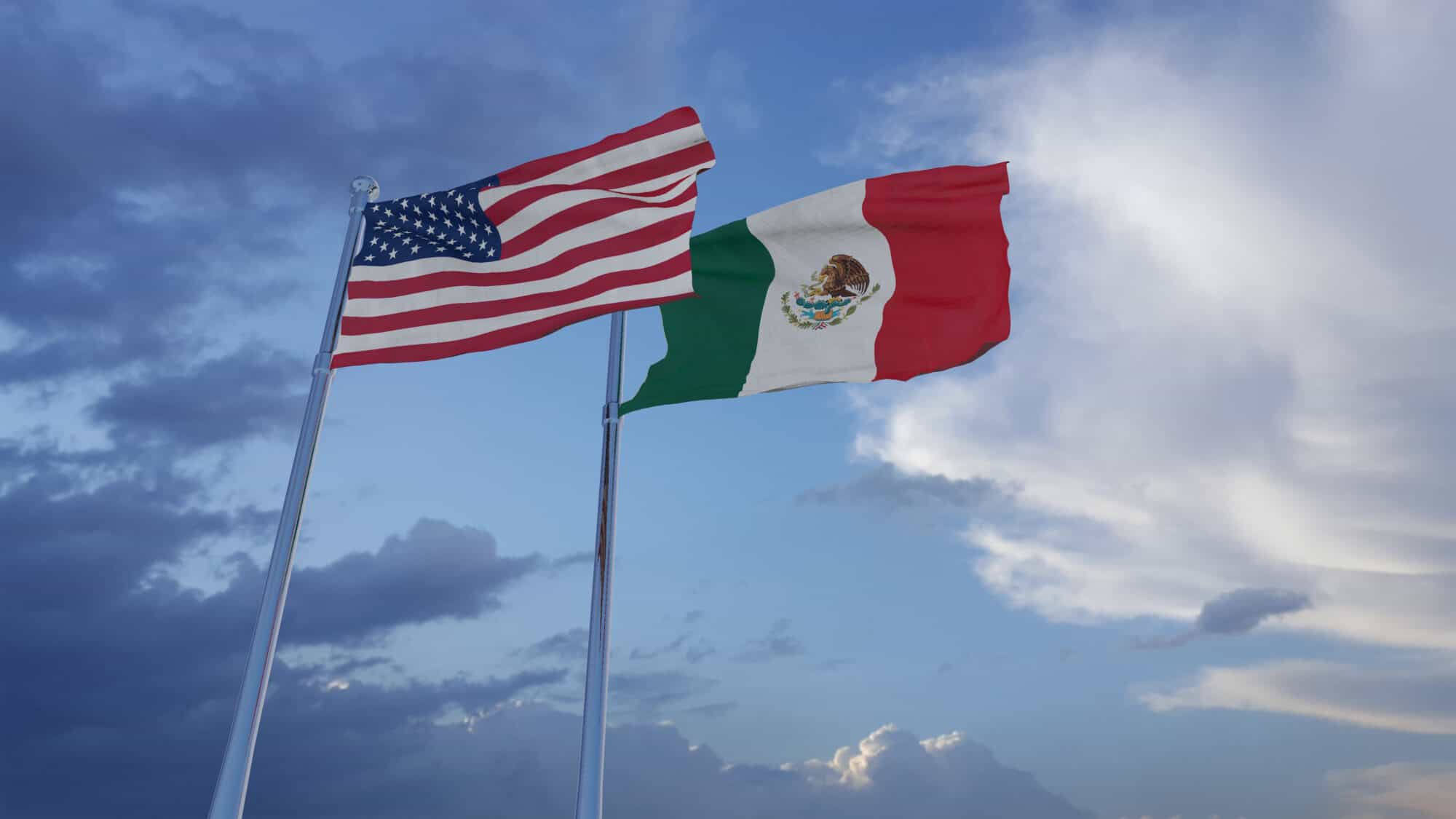
The outgoing Biden administration is undermining a U.S. manufacturer in its high-stakes dispute with the Mexican government by “seeking to erode investor-state dispute settlement (ISDS) protections under U.S. trade agreements with Colombia, Mexico and Canada,” a recent Wall Street Journal (subscription) editorial revealed.
The problem: ISDS protections safeguard U.S. investments from foreign governments seeking to interfere with or appropriate them, as the predicament of Vulcan Materials Company shows.
- Vulcan has been embroiled in a dispute with the Mexican government since 2018, when the government shut down some of its quarrying operations, according to Chairman and CEO J. Thomas Hill.
- The unwarranted shutdown forced the company to pursue arbitration under NAFTA, but the situation only got worse—former Mexican President Andrés Manuel López Obrador ordered all of Vulcan’s operations to cease in May 2022, including at a deepwater port the company built in the early 1990s.
- Now, the company is expecting its second round of arbitration to be decided by mid-2025—unless the Biden administration guts the investor protections in the U.S.–Mexico–Canada Agreement, handing a victory (and a key port) to the Mexican government.
Congressional fury: Both Congress and Vulcan itself learned of the administration’s efforts via The Wall Street Journal editorial, instead of directly from the Office of the U.S. Trade Representative. This is particularly egregious because the USTR is required to consult with Congress on investment obligations in trade deals.
- Bipartisan members of Congress have expressed their outrage, with Sen. Katie Britt (R-AL) writing in The Wall Street Journal (subscription) that “the Biden administration is negotiating away the due process of Americans, including my constituents, in the waning days of this lame-duck administration.”
- On Dec. 20, three bipartisan senators joined Sen. Bill Hagerty (R-TN) in condemning the USTR’s efforts on the Senate floor. “If Mexico is allowed to target, without repercussion, a company like Vulcan, one that employs thousands of Americans, and has operated responsibly in Mexico for decades, that means no American business is safe in Mexico,” Sen. Hagerty said.
- Sens. Tim Kaine (D-VA) and Tommy Tuberville (R-AL) joined both Sens. Britt and Hagerty in calling on Congress to pass the Defending American Property Abroad Act, which would impose penalties on Western Hemisphere countries that unlawfully seize the assets of American firms.
The NAM says: The NAM is calling on the USTR to halt this effort immediately, said NAM Vice President of International Policy Andrea Durkin.
- “ISDS has a legitimate role in U.S. trade policy to ensure our manufacturers receive fair and equitable treatment by foreign governments and to protect against egregious expropriation or nationalization of U.S. investments without adequate and effective compensation.”
- “U.S. manufacturers are entitled—at a minimum—to be consulted about any proposed changes that would impact their right to due process in ongoing cases.”
NAM Co-Hosts Second Annual North American Manufacturing Conference
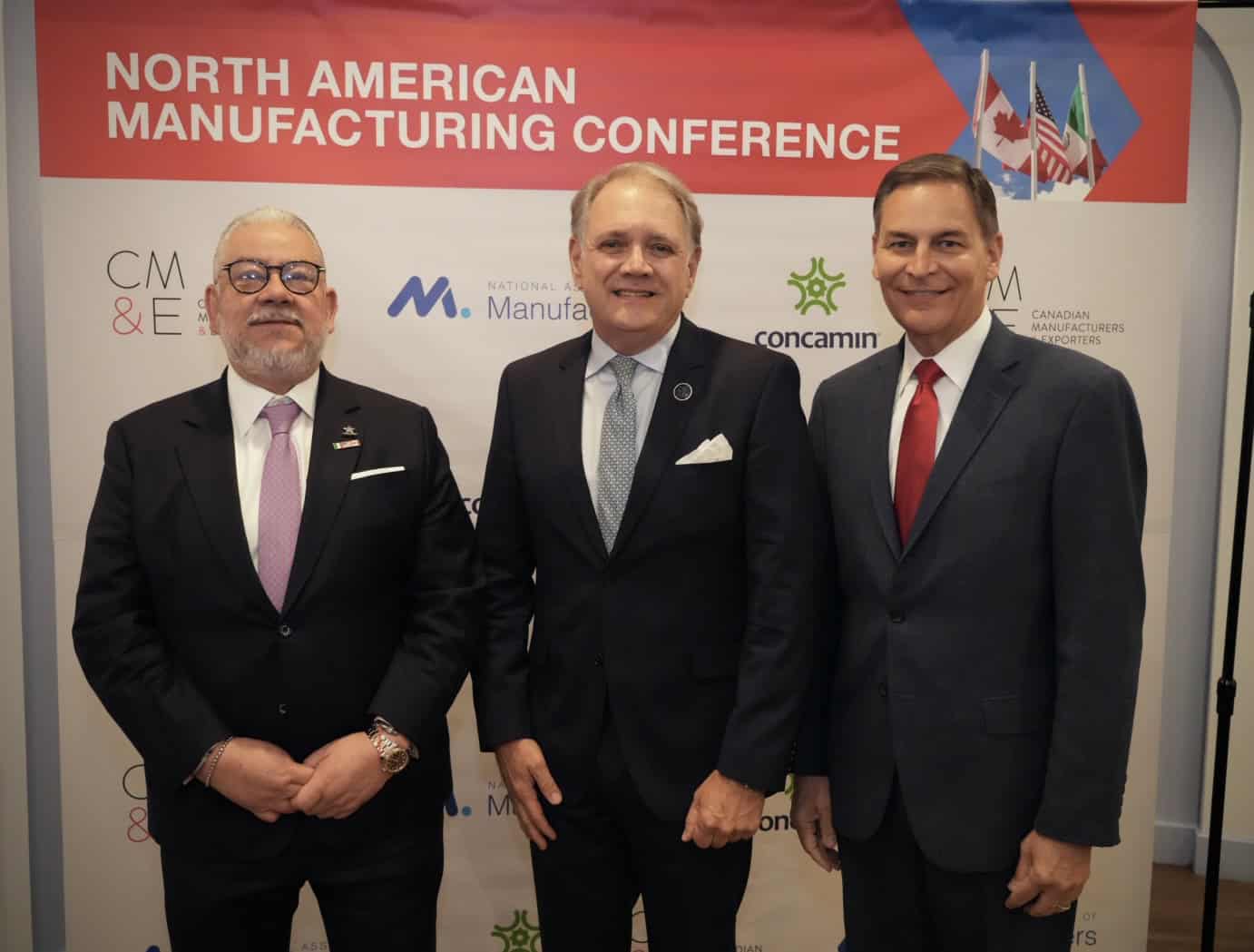
The NAM co-hosted the 2024 North American Manufacturing Conference on Tuesday and Wednesday in Ottawa, Canada, along with the Canadian Manufacturers & Exporters and the Confederation of Industrial Chambers of Mexico. This year’s conference kicks off the NAM’s advocacy push ahead of the expected review of the United States–Mexico–Canada Agreement.
Well-timed: The conference was timely, as President-elect Trump on Wednesday night announced his nomination of former U.S. Rep. Pete Hoekstra (R-MI) as the next U.S. ambassador to Canada—and touted the USMCA.
- Said NAM President and CEO Jay Timmons following the news: “We appreciate [President-elect Trump]’s foresight in prioritizing the U.S.–Canadian relationship and negotiating the USMCA, a trade deal that has been essential to the strength and success of manufacturing across North America. We look forward to working with [Hoekstra] as the next U.S. ambassador to Canada.”
- The conference also came just a day before significant news from Mexico: that its lower house of Congress approved a spate of constitutional reforms proposed earlier this year by former President Andrés Manuel López Obrador.
- Some of the reforms—which include the dismantling of several independent public regulatory agencies and restrictions on U.S. participation in the energy sector—appear to violate Mexico’s obligations under the USMCA.
“A crucial moment”: “[T]his conference is happening at … a crucial moment,” Timmons told event attendees on Tuesday. “We need to be clear-eyed about what we’re up against as we forge a more resilient and stronger North American manufacturing economy. Our associations and companies are at the vanguard. It will be up to us to make the case for vibrant economic ties and trade between our countries.”
Strong trade ties needed: The USMCA was a main topic at the conference, which consisted of multiple panel discussions and fireside chats with officials, experts and journalists from the U.S., Mexico and Canada.
- In talks on Tuesday with reporters from CNN and Canada’s Globe and Mail, Timmons highlighted the results of a recent joint NAM–CME-CONCAMIN survey. It found that “86% of [North American] manufacturers expressed strong support for extending the CUSMA/USMCA/T-MEC agreement when it comes up for review.”
- The conference’s panel events focused on different aspects of the USMCA. Speakers on one panel talked about key opportunities and challenges for the agreement in a shifting global landscape, while those on another keyed in on the effectiveness of the USMCA four years after its inception.
Speaker list: Event speakers included ExxonMobil Senior Vice President and NAM Executive Committee member Neil Chapman, U.S. Department of State Acting Assistant Secretary of Economic and Business Affairs Amy Holman, CONCAMIN President Alejandro Malagón Barragán, Canadian Minister of Innovation François-Philippe Champagne, CEMEX Vice President of Corporate Affairs Carlos Garza Galán, veteran POLITICO reporter Doug Palmer and many others.
- NAM Vice President of International Policy Andrea Durkin moderated a panel on the USMCA review. It featured Martinrea International Executive Chairman and Co-Founder Rob Wildeboer, 3M Government Affairs Head for the United States and Canada Elise Maheu and Xignux Public Affairs and Institutional Relations Director for the United States Iván Rivas.
- “The review is a novel mechanism in a trade agreement,” Durkin said after the conference. “Manufacturers in North America base their long-term plans on the benefits of the USMCA. They want the three governments to avoid a scenario that creates significant business uncertainty.”
Ministerial meetings: Timmons—who appeared Wednesday on CBC News’ “Power & Politics” to discuss the likely impact of the U.S. elections on North American trade—also spoke one-on-one to Canadian Minister of Labor and Seniors Steven MacKinnon and Minister of Energy Jonathan Wilkinson.
- Timmons thanked MacKinnon for the Canadian government’s intervention in the recent bicoastal Canadian port strikes, which reopened the points of entry, as well as his intervention to end a rail stoppage in the country.
- In his discussion with Wilkinson, Timmons told the energy minister the U.S. and Canada should “build cross-border relationships” to share access to critical minerals and materials including copper, lithium, uranium and graphite.
The final say: “North America’s integrated manufacturing system is the envy of the world,” Timmons said at the event. “We hold a competitive edge globally—and we can keep it if our governments stay true to the commitments set forth in the USMCA.”
Timmons: USMCA, Right Policies Can Bring “Manufacturing Revival”
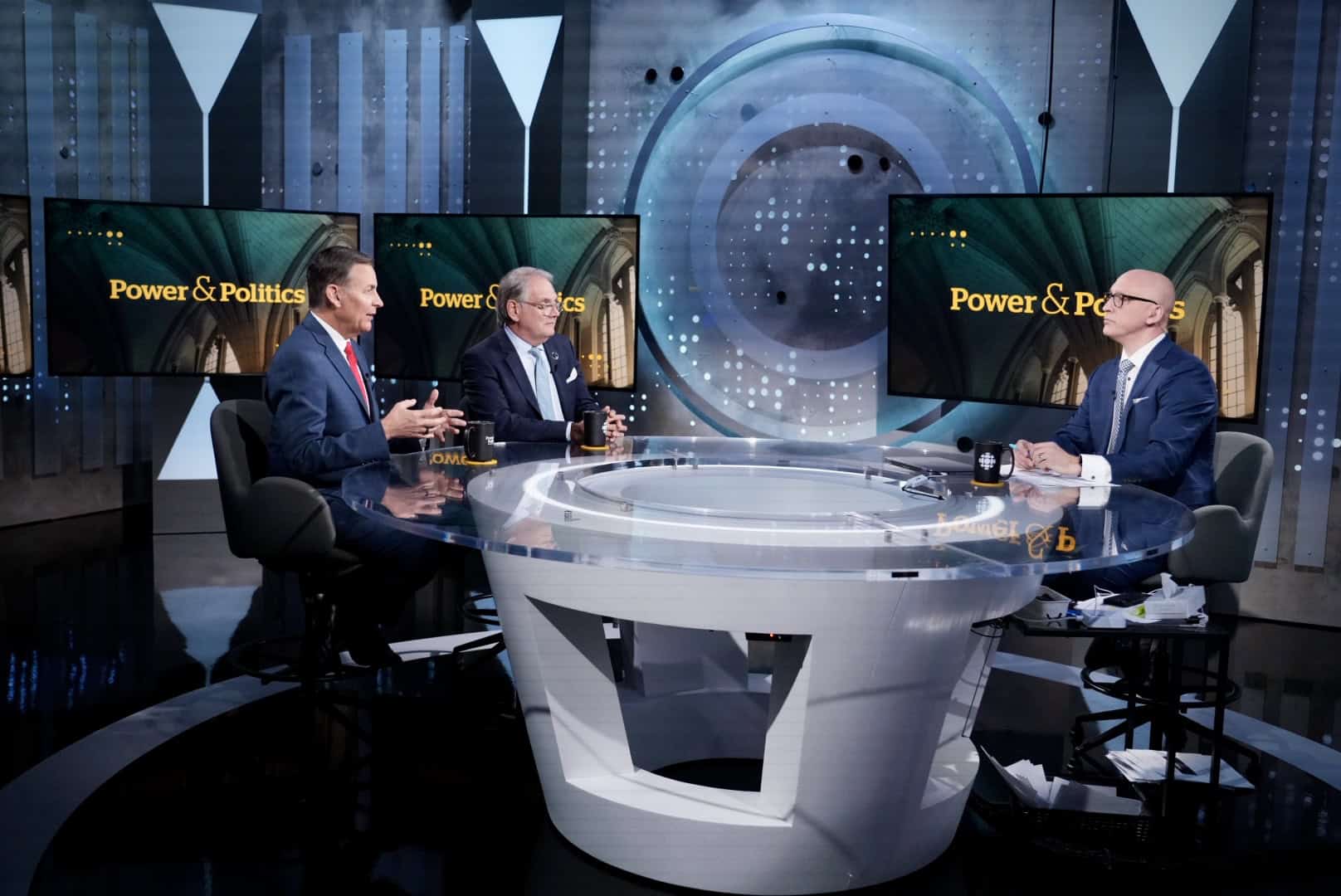
The North American trade landscape will look different once President-elect Trump takes office, NAM President and CEO Jay Timmons said this week—but “the special relationship” between the U.S. and Canada will only grow stronger.
What’s going on: “President Trump has been very clear about his priorities, his commitments,” Timmons said Wednesday in Ottawa on CBC News’ “Power & Politics,” where he was joined by Canadian Manufacturers & Exporters President and CEO Dennis Darby. Timmons was in Canada for this year’s North American Manufacturing Conference, hosted primarily by the CME.
- “[E]veryone in the business community and in adjoining governments need to be approaching the administration change with very clear eyes [because] … what Donald Trump says, Donald Trump means. Now, having said that, Donald Trump wants to see manufacturing in the United States grow and thrive.”
- Part of that prosperity will be continuing and strengthening United States–Mexico–Canada Agreement, which “has demonstrated that the regional economic activity that has been generated has been beneficial for all three countries,” Timmons continued.
On Mexico: “[W]e all should be concerned if the letter and the spirit of the agreement [of USMCA] are not being followed,” Timmons told “Power & Politics” host David Cochrane. While Mexican President Sheinbaum “has indicated that she wants to make sure that the agreement is ratified for the future,” the proposed constitutional amendments “have … [been] problematic for the United States.”
- Mexico has also had “some issues with takings of private property of American manufacturers,” Timmons added. “Those things can’t stand, so those are issues that will have to be addressed as the [USMCA] review process occurs in 2026, but hopefully the new administration in Mexico will address those things before then.”
Tariffs: Any tariffs imposed by the incoming Trump administration should be calibrated, said Timmons, whose visit to Canada also included meetings with Canadian Labour Minister Steven MacKinnon and Energy and Natural Resources Minister Jonathan Wilkinson.
- Tariffs should address “who’s causing the disruption, who’s causing the problem [and] … the policy that is causing the issue,” Timmons said. “And you need to really go right after that. Otherwise, [tariffs] are not going to be effective.”
“A manufacturing revival”: A respected, fully upheld USMCA is just one piece of the foundation that will usher in a new age of North American manufacturing, Timmons concluded.
- “[S]trengthening the manufacturing sector in the United States … [is] not just about trade,” he said. “In order to attract investment in the United States, we have to have the right tax policy, the right regulatory policies, the right workforce policies, the right energy policies, and the president-elect seems to be focused on all of those areas as well.”
- “So I feel pretty good about a manufacturing a continued manufacturing revival and renaissance in the United States. I think that’s good for the whole region.”
NAM Emphasizes USMCA, Protecting Investors in Mexico Meetings
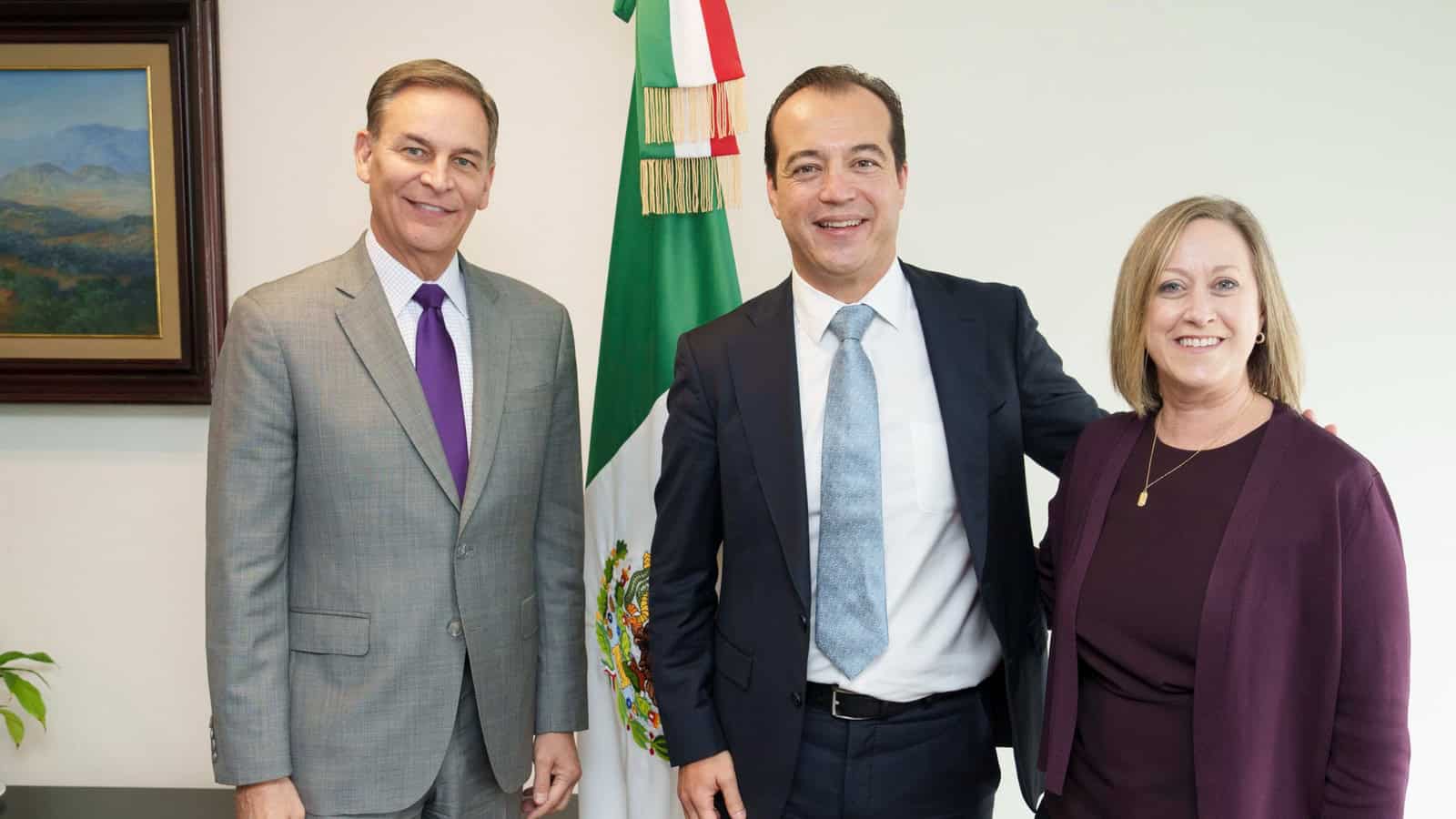
In high-level meetings with government, manufacturing and trade group leaders held in Mexico last week, the NAM hammered home a key message: For North American manufacturing to remain globally competitive, Mexico must protect investor holdings in the country.
What’s going on: During a jam-packed three-day visit to Mexico City, NAM President and CEO Jay Timmons and an NAM contingent met with top officials in the new Sheinbaum administration, as well as leadership at multiple agencies and associations.
- These included newly appointed Deputy Trade Minister Luis Rosendo Gutiérrez, the Business Coordinating Council (CCE), the Confederation of Industrial Chambers of Mexico (CONCAMIN), the Mexico Business Council (CMN), the National Council of the Export Manufacturing Industry (INDEX) and others.
What they said: The NAM’s main message at each gathering was the same: Companies investing in Mexico need assurance that their portfolios will be protected regardless of the fate of proposed judicial reforms in the country.
- The NAM also underscored the importance of the U.S.–Mexico–Canada Agreement, which is due for review in 2026, and the necessity of ensuring that the deal is upheld for all three parties.
- If its terms are respected, USMCA could help North American manufacturing outcompete China.
On China: This week, just days after his office’s meeting with the NAM, Gutiérrez announced that the Sheinbaum administration will seek U.S. manufacturers’ help to reshore—mainly from China—the production of some critical technologies (The Wall Street Journal, subscription).
- “We want to focus on supporting our domestic supply chains,” he told the Journal, adding that talks with U.S. companies are still in the informal stage.
The NAM says: “Manufacturing is at the heart of the USMCA,” said NAM Vice President of International Policy Andrea Durkin, who was part of the NAM group on the ground in Mexico. “The NAM intends to work to ensure that the agreement strengthens the competitiveness of manufacturers.”
Manufacturers on Port Strike: By Resuming Work and Keeping Our Ports Operational, They Have Shown a Commitment to Listening to the Concerns of Our Industry
Washington, D.C. – Following news that the International Longshoremen’s Association and the United States Maritime Alliance have reached an agreement to extend the Master Contract until Jan. 15, 2025, National Association of Manufacturers President and CEO Jay Timmons released the following statement:
“Manufacturers are encouraged that cooler heads have prevailed and the ports will reopen. By resuming work and keeping our ports operational, they have shown a commitment to listening to the concerns of manufacturers and other industries that rely on the efficient movement of goods through these critical gateways. This decision avoids the need for government intervention and invoking the Taft-Hartley Act, and it is a victory for all parties involved—preserving jobs, safeguarding supply chains and preventing further economic disruptions.
“Manufacturers depend on the stability of our ports to continue building, innovating, delivering products to American families and supporting communities across the country. We commend the International Longshoremen’s Association and the U.S. Maritime Alliance for coming together in the spirit of collaboration and urge both parties to use this time to reach a fair and lasting agreement. Another strike would jeopardize $2.1 billion in trade daily and could reduce GDP by as much as $5 billion per day. We cannot afford that level of economic destruction.”
-NAM-
The National Association of Manufacturers is the largest manufacturing association in the United States, representing small and large manufacturers in every industrial sector and in all 50 states. Manufacturing employs nearly 13 million men and women, contributes $2.87 trillion to the U.S. economy annually and accounts for 53% of private-sector research and development. The NAM is the powerful voice of the manufacturing community and the leading advocate for a policy agenda that helps manufacturers compete in the global economy and create jobs across the United States. For more information about the NAM or to follow us on Twitter and Facebook, please visit www.nam.org
Manufacturers Need 301 Exclusions Process to Compete Globally
De Minimis Rule Risks Throttling U.S. Supply Chains at Ports of Entry
Washington, D.C. – Following the U.S. Trade Representative’s announcement on the continuation of Section 301 tariffs on China and the White House’s announcement on de minimis, National Association of Manufacturers Vice President of International Policy Andrea Durkin released the following statement:
“A trade war never benefits anyone, and this announcement ignores the realities of today’s economy, potentially harming manufacturers’ ability to grow and invest in the U.S. Manufacturers operate in a rapidly shifting global economy, where tariffs have the potential to affect every industry and every product. To stay competitive, manufacturers must have the flexibility to apply for exclusions as market dynamics change. Without this process, companies of all sizes will be crippled by rigid policies that stifle growth and innovation.
“Raising the cost of critical clean energy inputs, without offering a process for exclusions, directly undermines the Biden administration’s goal of boosting clean energy manufacturing in the U.S. Policymakers must ask tough questions: Are we issuing permits for more domestic aluminum smelters and critical minerals refining for energy production applications? Will wafer and battery production be exempt from regulatory hurdles to ensure automotive and high-tech manufacturing is not slowed? The White House also announced today it will propose a rule significantly altering how goods enter our borders under de minimis, subjecting hundreds of millions of additional packages to scrutiny by CBP—which raises the question of how we will ensure that manufacturing supply chains are not disrupted by this massive new burden on the agency charged with protecting our ports of entry.
“These questions all point to one fact—that tariffs often fail to address the underlying problems they’re supposed to solve, while often complicating manufacturers’ efforts to improve the quality of life for everyone. We are asking the administration to implement an exclusion process that fairly accounts for the unintended consequences of tariffs on our industry’s ability to create jobs and reach the 95% of customers around the world.”
-NAM-
The National Association of Manufacturers is the largest manufacturing association in the United States, representing small and large manufacturers in every industrial sector and in all 50 states. Manufacturing employs nearly 13 million men and women, contributes $2.89 trillion to the U.S. economy annually and accounts for 53% of private-sector research and development. The NAM is the powerful voice of the manufacturing community and the leading advocate for a policy agenda that helps manufacturers compete in the global economy and create jobs across the United States. For more information about the NAM or to follow us on Twitter and Facebook, please visit www.nam.org.
